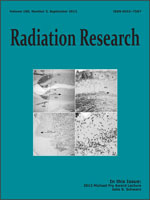The effect of transgenerational exposure to low dose rate (2.4 and 21 mGy/day) gamma irradiation on the yield of DNA double-strand breaks and oxidized guanine (8-hydroxyguanine) has been studied in the muscle and liver tissue of a model organism, the Japanese medaka fish. We found the level of unrepaired 8-hydroxyguanine in muscle tissue increased nonlinearly over four generations and the pattern of this change depended on the radiation dose rate, suggesting that our treatment protocols initiated genomic instability and an adaptive response as the generations progressed. The yield of unrepaired double-strand breaks did not vary significantly among successive generations in muscle tissue in contrast to liver tissue in which it varied in a nonlinear manner. The 8-hydroxyguanine and DSB radiation yields were significantly higher at 2.4 mGy/day than at 21 mGy/day in both muscle and liver tissue in all generations. These data are consistent with the hypothesis of a threshold for radiation-induced activation of DNA repair systems below which tissue levels of DNA repair enzymes remain unchanged, leading to the accumulation of unrepaired damage at very low doses and dose rates.
How to translate text using browser tools
6 August 2013
DNA Damage Caused by Chronic Transgenerational Exposure to Low Dose Gamma Radiation in Medaka Fish ( Oryzias latipes)
D. Grygoryev,
O. Moskalenko,
T. G. Hinton,
J. D. Zimbrick
ACCESS THE FULL ARTICLE

Radiation Research
Vol. 180 • No. 3
September 2013
Vol. 180 • No. 3
September 2013




